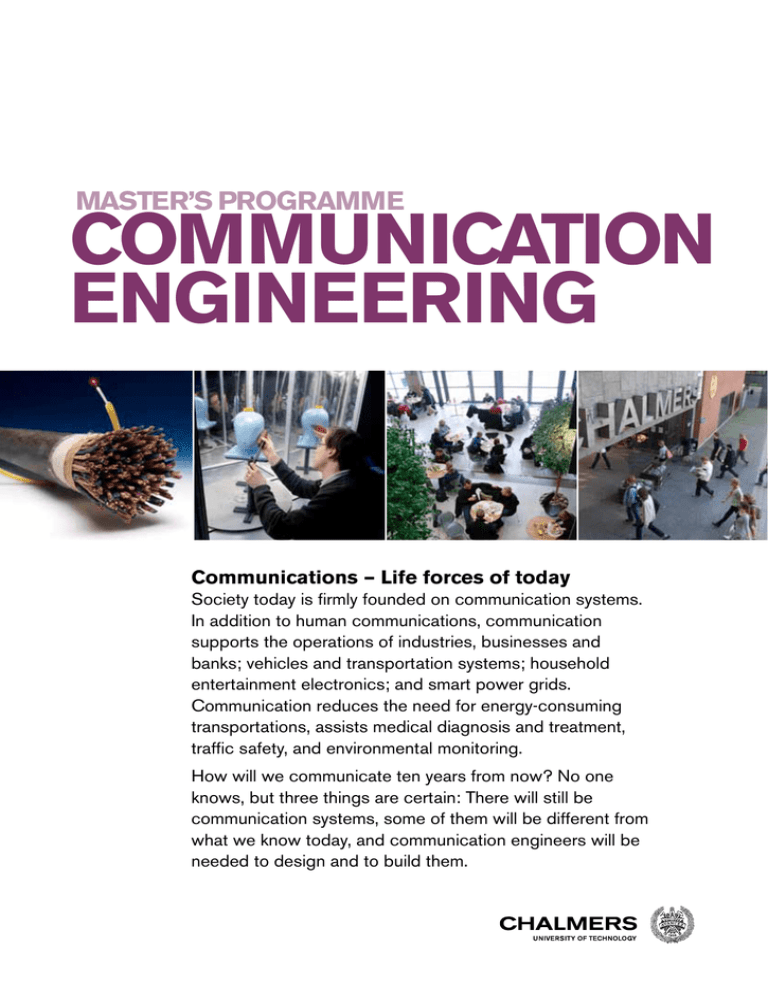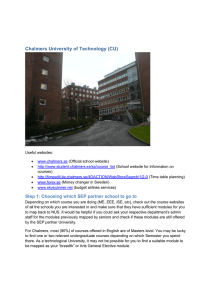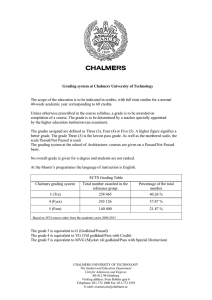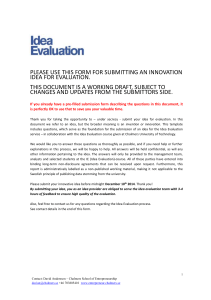COMMUNICATION ENGINEERING
advertisement

MASTER’s PROGRAMME COMMUNICATION ENGINEERING Communications – Life forces of today Society today is firmly founded on communication systems. In addition to human communications, communication supports the operations of industries, businesses and banks; vehicles and transportation systems; household entertainment electronics; and smart power grids. Communication reduces the need for energy-consuming transportations, assists medical diagnosis and treatment, traffic safety, and environmental monitoring. How will we communicate ten years from now? No one knows, but three things are certain: There will still be communication systems, some of them will be different from what we know today, and communication engineers will be needed to design and to build them. AIMS The programme prepares you for an advanced career in design, development, research or Ph.D. studies in the field of communication engineering. This is achieved by essentially focusing on the fundamental principles that govern the design, performance, and limitations of communication systems of the past, present as well as the sustainable future. RESEARCH CONNECTIONS The professors at the department are themselves internationally recognized in their respective fields and are engaged in collaborative research with researchers from the top universities around the world. Also, the department is engaged actively in research and development projects with leading companies such as Ericsson, Volvo, Nokia Siemens Networks etc. CAREER OPPORTUNITIES In general, graduate study in communication engineering will prepare students to pursue careers in diverse, high-technology areas. These careers can be in the government, and the industry. Most of the alumni of this programme work as technical specialists in design, development, and maintenance of communication technology. Some have progressed to leading positions in the industry and academia. Several international telecom players like Ericsson actively recruit our graduate students on a regular basis. And there are plenty of smaller companies specializing in the area of communications in Sweden that have recruited students from our programme. In recent times, the automotive industry has evinced interest in engineers with advanced knowledge in Communication technologies, given that all modern cars include an internal communication network, and vehicle-to-vehicle communication. Vehicular safety systems is currently a hot area of design, development and research. Many of our former students are also pursuing a Ph.D. degree at various European and American universities. EDUCATIONAL METHODS The pedagogical structure of the programme is well targeted towards learning system design processes as practiced in the communication industry. In general, the educational methods are based on what are expected from engineering graduates in an industrial environment, with specific emphasis on building and refining problem-solving skills, team work and presentation skills. Certain emphasis is placed on solving complex tasks by defining subtasks and interfaces, performing these subtasks independently, and assembling the results. All courses in the program are permeated by the principles of sustainable development. Students get the opportunity to interact with the industry via guest lectures and study visits. Finally, the Master’s Thesis gives the student training in individual research, project planning, documentation and presentation. It can be carried out at the University, industry or another university/research institute. COMMUNICATION ENGINEERING UNDERGRADUATE PROFILE Major in Electrical Engineering, Automation and Mechatronics Engineering, Com- puter Engineering, Computer Science, Information Engineering, Mathematics or Engineering Physics. PREREQUISITES Signals and systems theory (including linear systems and transforms), Basic programming and Mathematics (including probability and linear algebra). PROGRAMME PLAN The first semester of the programme consists of an initial mandatory block of 30 ECTS credit units, consisting of four of the five compulsory courses described below. In the second semester, the fifth mandatory course is taught along with a set of semi-elective courses, out of which the student must choose at least one during the second semester. In the third semester, the students must choose at least two of the given set of courses. Among the semi-elective courses, there are two courses named “Advanced Topics in Communications” and “Advanced Topics in Signal Processing” that are research oriented courses of a more advanced nature than the others. The topics for these courses are different from year to year. In the fourth semester, the master thesis should be done. COMPULSARY COURSES • Introduction to Communication Enginee ring gives an overview of fundamental concepts in communication engineering and insight into modern communication standards, with some emphasis on com mercial wireless systems. • Random Signal Analysis gives the ne cessary tools for understanding sto chastic models of signals and noise. The course covers various characterizations of random signals as well as statistical inference (estimation) based on these. • In Digital Communications, we derive a theoretical framework for analyzing and designing advanced communication sys- tems, based on stochastic methods. The course covers methods for digital modu- lation, coding and detection. • In Applied Signal Processing, you learn standard techniques and get insight in applications of digital signal processing. You are also given the opportunity to app- ly some of the techniques to semireal sig- nal processing problems and you get insight into current practice in industry. • Wireless Communications is concerned with the design of wireless communica tion systems, where you acquire enough understanding of the wireless channel and state of technology to explain why today’s systems are designed as they are and how they can be improved. SEMI-ELECTIVE COURSES After the mandatory courses are completed, the students can pursue a specialization of their interest. The semi-elective courses are divided into hardware-related and algorithm-related courses, and it is recommended that the students decide their main area between these two. Thus, it is recommended that the students choose either (at least) three algorithm-related or three hardware-related courses among the set of semi-elective courses. Hardware-related Semi-Elective Courses Optoelectronics, Microwave Engineering, Electromagnetic Waves and Components, Mixed-Signal System Design, Introduction to Electronic System Design, Fiber-optical communication, Introduction to Integrated Circuit Design, Laser Engineering, Antenna Engineering, Fundamentals of photonics, Radar systems and applications. Algorithm-related Semi-Elective Courses – Remote Sensing, Wireless Networks, Multimedia and Video Communications, Image analysis, eHealth, Advanced Topics in Communications, Advanced Topics in Signal Processing, Network Security, Computer Networks, Satellite Positioning, Image processing, Satellite Communications. It is also recommended to supplement the technical courses with courses related to management, environment, society, economy and English that help build general competency. MASTER THESIS In the fourth semester, the Master’s Thesis of 30 ECTS credit units should be done. The work can be conducted within one of our research divisions or within a company. Even though it is scheduled for the spring semester, the timing of the Thesis is somewhat flexible in order to allow a wider selection of elective courses. Year 1 Year 2 Introduction to Communication Engineering Digital Communications Wireless Communications Random Signals Analysis Applied Signal Processing Semielective courses Autumn Communication hard-ware related Communication algorithm related Semielective courses Spring Semielective courses Master’s Thesis Autumn Spring Laser engineering Introd.to Electronic Syst. Design Mixed-Signal System Design Radar syst. & applications Electromag. Waves and Components Fiber-optical communication Antenna Engineering Optoelectronics Microwave Engineering Remote sensing eHealth Introd. to Integrated Circuit Design Image analysis Wireless Networks Image processing Wireless link project Adv. topics in communications Multimedia/ Video Communic. Satellite communicat. Satellite positioning Adv Topics in Signal Processing Computer networks Probability & random proc. advanced level Fundamentals of photonics Network security COMMUNICATION ENGINEERING “Chalmers – for a sustainable future is a vision which exudes the long-term approach, the acceptance of responsibility and the trust I feel is worthy of Chalmers. At the same time, it is obvious that this vision has to be shared by many and that Chalmers has to co-operate across disciplines in order to promote the whole of society’s commitment to our future.” Karin Markides, president Chalmers conducts research and edu­ca­tion in engineering and natural scien­ces, architec­ture, technology-relat­ed mathe­mati­cal scienc­­es and nautical sciences – in close collaboration with industry and society. Chalmers is one of Sweden’s largest universities of technology with about 12 000 students and 2 200 em­ployees. Approximately 40 percent of Sweden’s graduate engineers and architects are educated here. Chalmers has formed partnerships with major industries mostly in the Gothenburg region such as Ericsson, Volvo and SKF. The Master’s Programmes at Chalmers are strongly linked to advan­c­ ed research in areas of particular strength. Upon completion of studies, candidates will be granted a Master’s degree. The programmes are taught in English and open to applicants from the whole world. Chalmers has eight areas of advance where the aim is to bring together research, education and innovation across departmental boundaries and to co-operate with bodies and organisations out­side Chalmers: Materials Science, Produ­c­tion, Information & Communica­­­ tion Technology, Transport, Built Environment, Nano­science & Nano­ technology, Life Science and Energy. The eight key areas also have a firm foundation in the basic sciences. The pursuit of new knowledge and improved technology has characterized Chalmers ever since its foundation in 1829. More info at: www.chalmers.se/en The small metropolis – GOTHENBURG More than 60 000 are currently studying in Gothenburg. In many ways, their decision to choose Gothenburg when the time came to take the next step into the future isn’t surprising. Gothenburg is an attractive major city with a maritime atmosphere and within easy reach of outdoor activities in the rest of West Sweden. Gothenburg is an uncommonly inviting city for students, with a great deal to offer: You’ll find an exciting cultural and entertainment scene worthy of any major city, as well as a friendly atmosphere that will help you to quickly feel at home. Founded in 1621, Gothenburg is a young city by European standards. Since formative years it has been an important port of international trade and today it is the largest in Scandinavia. With a population of about half a million, it is both friendly and cosmopolitan. More info at: www.goteborg.com SWEDEN – A CULTURE OF INNOVATION One of the world’s most modern countries, Sweden is the birthplace of many successful international corporations. Innovative research at Swedish universities and companies has resulted in a number of successful inventions. Some examples are: the computer mouse, Bluetooth for internet mobility, the pacemaker, the ball bearing, the Tetra Pak beverage packaging system, the dialysis machine and internet applications such as the online music streaming service Spotify and the free internet calling service Skype.These fairly recent inventions build on a long history of excellence in academia and research. Sweden is the home of the prestigious Nobel Prize, awarded in Stockholm every year. Sweden has a number of large multinational corporations, such as telecom supplier Ericsson, automotive companies Volvo and Scania, household appliances corporation Electrolux, bearing manufacturer SKF, and high-tech engineering groups Sandvik and Atlas Copco. The deep-rooted creative environment has made Sweden a strong nation in the areas of design, fashion and music, with well-known international brands such as furniture giant IKEA and clothes retailer H&M. Sweden is also one of the largest music-exporting countries in the world. More info at: www.studyinsweden.se Chalmers University of Technology, SE-412 96 Gothenburg, Sweden, Phone +46 31 772 1000 Foto och grafisk design, Chalmers, 2012 Chalmers University of Technology




